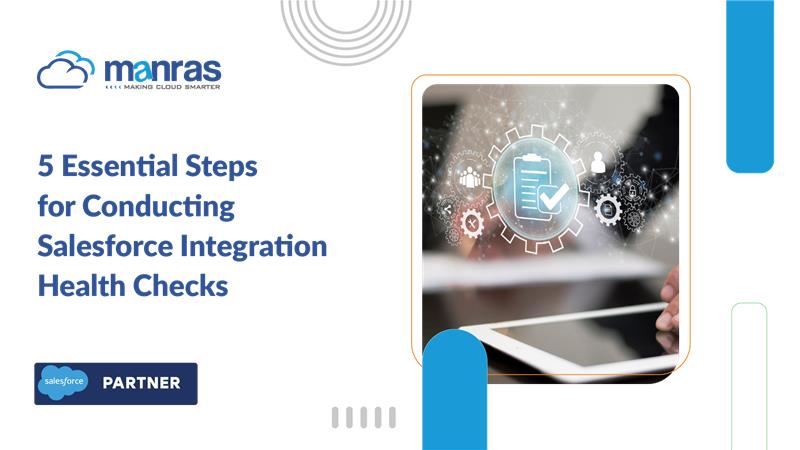
5 Essential Steps for Conducting Salesforce Integration Health Checks
Organizations today rely on Salesforce integrations to improve efficiency and streamline operations across various departments. These integrations play a crucial role in ensuring that data flows seamlessly between systems, enabling teams to access essential information promptly. However, as these integrations grow in complexity, the need for regular integration health checks becomes vital to ensure their effectiveness.
In this article, we will cover five essential steps for Salesforce integration health checks to ensure your integrations are efficient, secure, and aligned with integration best practices.
Importance of Salesforce Integration Health Checks
Regular Salesforce integration health checks are crucial for several reasons. They help maintain Salesforce data quality, ensuring that the information flowing between systems remains accurate and consistent. Inaccurate data can lead to misguided decisions, resulting in poor customer experiences and lost revenue.
Moreover, monitoring Salesforce integrations effectively enables businesses to monitor performance effectively, identifying issues such as response times and error rates that can hinder operational efficiency. This proactive approach mitigates risks and enhances the overall security of the Salesforce platform. By regularly assessing integrations, organizations can better protect sensitive data and comply with necessary security regulations.
How to Conduct Salesforce Integration Health Checks?
Here is how you can effectively conduct Salesforce integration health checks to ensure your integrations remain efficient and aligned with business objectives.
Step 1: Assess Integration Requirements
To conduct effective Salesforce integration health checks, begin by evaluating your current business needs. Understanding how each integration supports your organization’s objectives is essential. Consider questions such as: What specific business functions does each integration support? Are there new business requirements that necessitate adjustments to existing integrations? Additionally, identify whether all integrations are actively used or if there are redundant ones that can be eliminated. This assessment ensures that each integration remains relevant and efficient, aligning with your strategic goals and enhancing your Salesforce monitoring efforts.
Step 2: Review Data Quality
Next, ensure Salesforce data quality by scrutinizing the accuracy and consistency of data transferred between systems. Issues like outdated information, duplicate records, or improper data mapping can lead to significant problems, including incorrect analyses and poor decision-making. Conduct a thorough review of the data flowing through each integration. Implement data validation rules, perform regular audits, and utilize automated data cleansing tools to maintain high-quality standards. By adhering to integration best practices, you can significantly improve data reliability and build trust among stakeholders.
Step 3: Check Integration Performance
Monitoring integration performance is vital for maintaining a healthy Salesforce environment. Regular checks on response times and error rates help identify bottlenecks or failures. Use Salesforce monitoring tools to track key performance metrics like latency, throughput, and integration error frequency. If any integrations are underperforming, analyze their configurations and processes to uncover root causes. Proactive monitoring can prevent minor issues from escalating into major disruptions, ensuring that all components of your Salesforce integration work seamlessly together.
Step 4: Evaluate Integration Security
Integration security is a top priority for Salesforce admins, especially when managing sensitive data. Evaluate the security measures associated with each integration to ensure they meet industry standards. This evaluation should include assessing user permissions and access levels, regularly reviewing OAuth tokens, and revoking those that are no longer necessary. Additionally, implement monitoring for unusual activities or unauthorized access attempts. By thoroughly assessing security protocols, organizations can mitigate risks and protect valuable data, underscoring the importance of Salesforce integration health checks.
Step 5: Document Findings and Action Plans
The final step involves creating a comprehensive report that documents your findings and outlines action plans for identified issues. This documentation provides stakeholders visibility into integration health, tracks changes over time, and serves as a reference for future audits. Include essential details such as the purpose of each integration, Salesforce data quality status, performance metrics, security assessments, and recommended actions. By maintaining organized documentation, organizations can prioritize remediation efforts and ensure integrations continue to function effectively, reinforcing best practices for Salesforce data integration.
Conclusion
In conclusion, knowing how to perform Salesforce integration audits is vital for ensuring the effectiveness and security of your integrations. These checks help identify potential issues and maintain data accuracy, which is essential for informed decision-making. By prioritizing these evaluations, organizations can enhance their operational efficiency and ensure that their Salesforce environment continues to align with business objectives.
For expert assistance, consider Manras, a certified Salesforce consultant. Manras provides tailored solutions to optimize your Salesforce integrations, helping you implement integration best practices and enhance your overall Salesforce monitoring efforts.



